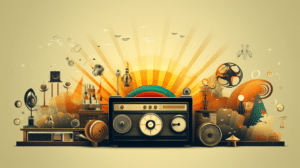In the vast symphony of advertising, radio has long been a resounding melody, captivating audiences with its timeless allure. From its humble beginnings to its enduring impact, radio advertising has evolved and adapted, remaining a powerful force in the ever-changing advertising landscape. With its ability to target specific audiences, create lasting brand impressions, and harness the intimate power of the human voice, radio advertising continues to resonate, proving that even in a digital world, the power of sound remains unmatched.
Key Takeaways
- Radio advertising has a long history, with the first official radio ad appearing in America in 1922.
- The UK saw its first radio ad in 1973, much later than America.
- Radio advertising offers incredible reach, with 93% of adults listening to the radio each week.
- The enduring nature of radio advertising is due to its unique ability to engage and connect with audiences.
The Birth of Radio Advertising
The development of radio advertising can be traced back to the early 1900s when companies began experimenting with broadcasting entertainment and news alongside Morse code transmissions. Since then, radio advertising has undergone numerous innovations and faced various challenges in the
Pioneers and Innovators in Radio Advertising
Pioneers and innovators in the radio communication industry have played a crucial role in the development and success of advertising through this medium. Their groundbreaking efforts have paved the way for innovative radio ad campaigns that have captivated audiences and delivered exceptional results for brands. Here are four critical contributions made by pioneers in radio advertising:
- Introduction of the first official radio ad: The WEAF organization in America developed the first radio ad in 1922, marking the beginning of a new era in advertising.
- Sponsorship of entire programs: During the golden age of radio, advertisers sponsored real programs, allowing them to produce humorous messages and catchy jingles that became iconic.
- Expansion of radio advertising beyond the US: While radio advertising appeared earlier in America, pioneers in other countries, such as Birdseye Frozen Food in the UK in 1973, significantly contributed to its growth worldwide.
- Continued impact and relevance: Despite the rise of digital marketing, radio advertising remains a powerful and effective medium, with studies showing its ongoing effect on consumer behavior.
The creativity and ingenuity of these pioneers have shaped the industry and continue to influence how we advertise through radio.
Evolution of Radio Advertising Techniques

The Impact of Radio Advertising on Consumer Behavior
Radio advertising profoundly influences consumer behavior, shaping purchasing decisions and brand preferences. The psychology behind radio advertising is a critical factor in its effectiveness. Here are four ways radio advertising impacts consumer behavior:
- Emotional connection: Radio ads can evoke emotions through storytelling, music, and voice acting. Brands can influence their purchasing decisions by creating an emotional connection with listeners.
- Familiarity and repetition: Radio ads often use catchy jingles or memorable voices to create understanding and repetition. This repetition helps reinforce brand messaging and increase brand recall when consumers make purchasing decisions.
- Visual imagery: Although radio is an audio medium, its casual imagery in the minds of lilistenersRadioan creates lasting impressions and influences consumer behavior.
- Meas by tapping into the power of imagination during effectiveness: Measuring the effectiveness of radio ads can be challenging compared to other advertising mediums. However, techniques such as tracking customer response rates, conducting surveys, and analyzing website traffic can provide valuable insights into the impact of radio advertising on consumer behavior.
The Power of Radio Jingles and Catchy Ads
The use of catchy jingles and memorable ads on radio can create a lasting impression on listeners and influence their purchasing decisions. The psychology of catchy songs in radio advertising is fascinating. These jingles can get stuck in our heads, creating a
| Psychology of Catchy Jingles | Role of Storytelling |
|---|---|
| Get stuck in our heads | Engage listeners |
| Create strong associations | Make the message relatable |
| Tap into emotions | Captivate the audience |
| Make the advertisement memorable | Leave a lasting impact |
Radio Advertising’s Role in Targeted Marketing
Targeted marketing has become increasingly important in advertising, allowing brands to tailor their message to specific demographics and increase the effectiveness of their campaigns. Radio advertising is crucial in this strategy, providing a unique platform to reach and engage with specific target audiences. Here’s how radio advertising contributes to targeted marketing:
- Role of radio advertising in brand storytelling: Radio allows brands to tell their story through audio, creating a personal and emotional connection with listeners. By using voice talent, sound effects, and music, brands can craft a narrative that resonates with their target audience and builds brand loyalty.
- Measuring the effectiveness of radio advertising campaigns: Radio advertising offers various metrics for measuring campaign effectiveness, such as reach, frequency, and listener engagement. Brands can track the number of listeners reached and the frequency of ad exposure and evaluate the impact of their ads through listener response and feedback.
- Customizable advertising opportunities: Radio provides customizable advertising opportunities based on the brand’s needs. Whether it’s a live read, a jingle ad, a personified commercial, or sponsoring an entire show, brands can choose the format that aligns with their target audience and marketing goals.
- Amplifying brand messages through multiple channels: Radio advertising can be integrated with other marketing channels, such as digital platforms like streaming services. By leveraging the reach of radio and combining it with digital media, brands can amplify their message and engage with their target audience across different touchpoints.
Radio Advertising Vs. Digital Marketing: a Comparative Analysis
When comparing the effectiveness of radio advertising and digital marketing, it is essential to consider each medium’s unique advantages and challenges in reaching and engaging with target audiences. Here is a comparative analysis of radio advertising and digital marketing:
| Aspect | Radio Advertising | Digital Marketing |
|---|---|---|
| Reach | Reaches 93% of adults each week | Can get a global audience |
| Targeting | Precise targeting based on demographics, interests, location | Can target specific demographics and interests |
| Cost | Generally more affordable than digital marketing | Prices can vary depending on the platform and strategy |
| Engagement | The human voice brings intimacy and emotion | Interactive features can enhance engagement |
| Measuring ROI | It can be challenging to measure direct ROI | Advanced analytics allow for precise ROI measurement |
| Flexibility | Customizable advertising opportunities | Offers a wide range of ad formats and targeting options |
Measuring the ROI for radio and digital ads can be challenging. While radio advertising has a proven track record of delivering a high return on investment, it can be difficult to attribute sales to radio ads directly. On the other hand, digital marketing allows for more precise tracking and measurement of ROI through advanced analytics tools. Ultimately, the choice between radio advertising and digital marketing depends on the campaign’s specific goals and target audience. Both mediums have pros and cons, and a well-rounded marketing strategy may involve a combination of both.
The Global Reach of Radio Advertising
With its ability to connect with listeners worldwide, radio advertising has become a powerful tool for brands to expand their reach and engage with a global audience. The global reach of radio advertising can have a significant cultural impact, allowing brands to communicate their message to diverse audiences across different countries and regions. Here are four key reasons why radio advertising has such a broad global reach and cultural impact:
- Language Adaptation: Radio advertisements can be easily translated and adapted to different languages, ensuring that brands can effectively communicate with local audiences in their native language.
- Localized Content: Radio advertisements can incorporate local cultural references, music, and voices, making them more relatable and resonant with audiences in specific regions.
- Accessibility: Radio is accessible to many audiences, including those in remote areas or areas with limited internet access. This accessibility ensures that brands can reach audiences in various regions, including those who may not have access to digital platforms.
- Emotional Connection: Radio uniquely can create an emotional connection with listeners through the power of sound and storytelling. This emotional connection transcends cultural boundaries and allows brands to connect with audiences on a deeper level.
The Enduring Influence of Radio Advertising in the Digital Age
In an era dominated by digital media, radio advertising maintains its relevance and influence, proving to be a resilient and enduring medium in the ever-evolving marketing and communication landscape. Despite the rise of social media and online platforms, radio advertising offers unique advantages contributing to its enduring influence.
One of the critical roles of radio advertising is its ability to engage in brand storytelling. Through carefully crafted scripts, voiceovers, and sound effects, radio ads have the power to captivate listeners and create a memorable narrative that resonates with the audience. This storytelling approach allows brands to connect with consumers deeper, evoking emotions and building a stronger brand identity.
Furthermore, radio advertising has been found to impact customer loyalty positively. A study by Nielsen revealed that consumers exposed to radio ads were more likely to have a favorable opinion of the brand and consider purchasing from them. The intimate and personal nature of radio allows for a more meaningful connection with the audience, fostering loyalty and trust.
The following table illustrates the role of radio advertising in brand storytelling and its relationship with customer loyalty:
| Part of Radio Advertising in Brand Storytelling | Relationship Between Radio Advertising and Customer Loyalty |
|---|---|
| Engages listeners through captivating narratives | Builds trust and loyalty through personal connection |
| Evokes emotions and creates a memorable experience | Increases brand favorability and consideration |
| Conveys brand values and identity | Fosters a sense of familiarity and affinity |
The Future of Radio Advertising: Trends and Predictions
As technology continues to advance, the future of radio advertising is evolving with the emergence of new trends and predictions. Here are some key developments to watch out for:
- The rise of podcast advertising: With the growing popularity of podcasts, advertisers are recognizing the potential to reach engaged and loyal audiences through this medium. Podcast advertising allows for targeted messaging and integration within relevant content.
- Innovative approaches to radio ad production: Advertisers are exploring creative ways to capture listeners’ attention as competition increases. This includes immersive sound design, storytelling techniques, and collaborations with popular influencers or celebrities.
- Integration of digital platforms: Radio advertising is no longer limited to traditional broadcast channels. Integrating digital media like streaming services and online radio allows for greater reach and targeting capabilities.
- Data-driven advertising strategies: With advanced analytics and audience insights, advertisers can tailor their radio campaigns based on specific demographics, interests, and behaviors. This data-driven approach ensures more effective and efficient advertising.
As the landscape of radio advertising continues to evolve, embracing these trends and predictions will be crucial for staying relevant and maximizing campaign success.
Frequently Asked Questions
How Has Radio Advertising Evolved Over Time?
Radio advertising has evolved significantly over time, impacting consumer behavior profoundly. The evolution of radio advertising has seen the development of various types of ads, including live reads, jingle ads, personified commercials, and sponsored ads. Today, radio advertising offers incredible reach and precise targeting opportunities, making it a valuable method of promotion. Despite digital marketing advancements, radio advertising remains relevant and delivers a significant return on investment. The enduring impact of radio advertising can be attributed to the unique way we interact with audio media, creating visuals in our minds and engaging our cognitive processing.
What Are the Key Factors That Contribute to the Effectiveness of Radio Advertising?
The effectiveness of radio advertising is attributed to its ability to reach a target audience and deliver creative messaging. With radio’s broad reach and precise targeting opportunities, advertisers can connect with specific demographics, interests, and locations. Using well-known voices and catchy jingles makes ads memorable and helps brands stand out. Furthermore, radio’s enduring impact on listeners, its ability to engage the brain, and the intimate and emotional connection created through the human voice contribute to its effectiveness in promoting brands and influencing consumer behavior.
How Does Radio Advertising Compare to Digital Marketing in Terms of Reach and Impact?
Radio advertising and digital marketing are crucial in reaching and engaging with audiences. While digital marketing offers a broad reach and the ability to target specific demographics, radio advertising has unique advantages. Radio reaches 93% of adults weekly, providing incredible space and targeting opportunities based on demographics, interests, and location. Radio ads with well-known voices or catchy jingles can also make a brand memorable. Radio advertising continues to impact brand building and customer engagement significantly.
How Does Radio Advertising Contribute to Targeted Marketing Strategies?
Radio advertising contributes to targeted marketing strategies by utilizing storytelling and sound effects to captivate and engage specific audiences. Through the power of storytelling, radio ads can create emotional connections and convey brand messages effectively. Additionally, sound effects can be used strategically to enhance the impact of the news and create an immersive experience for the listeners. By tailoring the content and delivery of radio ads to specific target demographics, advertisers can maximize the effectiveness of their marketing efforts and reach the right audience with precision.
What Are Some Future Trends and Predictions for Radio Advertising?
Voice-activated ads and programmatic buying are two future trends shaping the landscape of radio advertising. With the rise of smart speakers and voice assistants, advertisers must effectively adapt their strategies to reach consumers through these platforms. Additionally, automated ad buying through programmatic technology will streamline purchasing radio ad space, allowing for more efficient and targeted campaigns. These trends highlight the evolving nature of radio advertising and the importance of staying ahead in a rapidly changing digital world.
Conclusion
Radio advertising has come a long way from its origins as a tool used by town criers or printed pamphlets distributed by radio flyers. The advent of radio broadcasting in the early 20th century allowed for the development of radio stations, which soon became a central platform for advertising campaigns across various industries. Since then, radio advertising has become an integral part of the advertising industry.
Throughout the decades, radio advertising has continued to innovate and adapt to new technologies. This has enabled radio stations to reach audiences in ways that were previously unimaginable. The introduction of digital advertising has allowed radio stations to expand their reach to the Internet, allowing them to access a larger pool of potential customers. Radio stations have also developed creative ways to personalize their advertising campaigns, making them more effective and engaging.
Radio advertising has also become increasingly sophisticated. Radio stations now have access to sophisticated research and analytics, enabling them to understand their target audiences better and tailor their advertising campaigns accordingly. Furthermore, radio stations have been able to leverage the power of the Internet, enabling them to create interactive and engaging experiences for their listeners. Through online advertising, radio stations have accessed new and creative ways to engage with their audiences, creating more memorable experiences.
The growth of radio line online advertising has also propelled the evolution of radio advertising. This form of advertising has enabled radio stations to reach audiences online, allowing them to access a larger pool of potential customers. Furthermore, radio line online advertising has enabled radio stations to understand their audiences better and tailor their advertising campaigns accordingly.
Overall, radio advertising has established a strong presence in the advertising industry. Its ability to reach targeted audiences through the power of the human voice has enabled it to create memorable experiences and influence consumer behavior. Furthermore, radio advertising has been able to evolve with the times, adapting to new technologies and trends while maintaining its relevance. As we look to the future, radio advertising will continue to be an essential tool in the advertising industry, offering a unique and effective platform for promotion. Keywords: radio station, political advertising, digital advertising, advertising campaigns, advertising industry, town criers, radio flyer, radio broadcasting, online advertising, advertising research, radio line online advertising.


Recent Comments